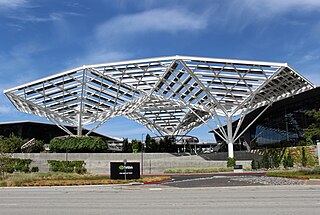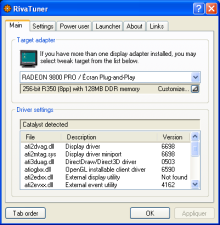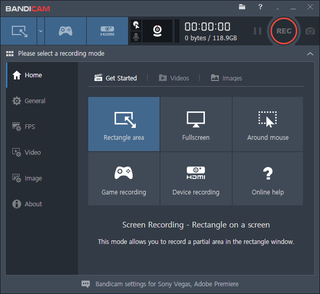
Nvidia Corporation is an American multinational corporation and technology company headquartered in Santa Clara, California, and incorporated in Delaware. It is a software and fabless company which designs and supplies graphics processing units (GPUs), application programming interfaces (APIs) for data science and high-performance computing as well as system on a chip units (SoCs) for the mobile computing and automotive market. Nvidia is also a dominant supplier of artificial intelligence (AI) hardware and software.

A graphics card is a computer expansion card that generates a feed of graphics output to a display device such as a monitor. Graphics cards are sometimes called discrete or dedicated graphics cards to emphasize their distinction to an integrated graphics processor on the motherboard or the central processing unit (CPU). A graphics processing unit (GPU) that performs the necessary computations is the main component in a graphics card, but the acronym "GPU" is sometimes also used to erroneously refer to the graphics card as a whole.

GeForce is a brand of graphics processing units (GPUs) designed by Nvidia and marketed for the performance market. As of the GeForce 40 series, there have been eighteen iterations of the design. The first GeForce products were discrete GPUs designed for add-on graphics boards, intended for the high-margin PC gaming market, and later diversification of the product line covered all tiers of the PC graphics market, ranging from cost-sensitive GPUs integrated on motherboards, to mainstream add-in retail boards. Most recently, GeForce technology has been introduced into Nvidia's line of embedded application processors, designed for electronic handhelds and mobile handsets.

A graphics processing unit (GPU) is a specialized electronic circuit initially designed to accelerate computer graphics and image processing. After their initial design, GPUs were found to be useful for non-graphic calculations involving embarrassingly parallel problems due to their parallel structure. Other non-graphical uses include the training of neural networks and cryptocurrency mining.

The GeForce 6 series is the sixth generation of Nvidia's GeForce line of graphics processing units. Launched on April 14, 2004, the GeForce 6 family introduced PureVideo post-processing for video, SLI technology, and Shader Model 3.0 support.

RivaTuner is a freeware overclocking and hardware monitoring program that was first developed by Alexey Nicolaychuk in 1997 for the Nvidia video cards. It was a pioneering application that influenced the design of subsequent freeware graphics card overclocking and monitoring utilities. It supports Nvidia GPUs from the Riva TNT to the GeForce 700 series, and has limited support for the ATI/AMD Radeon series of video cards from the Radeon 8500 and above.
PureVideo is Nvidia's hardware SIP core that performs video decoding. PureVideo is integrated into some of the Nvidia GPUs, and it supports hardware decoding of multiple video codec standards: MPEG-2, VC-1, H.264, HEVC, and AV1. PureVideo occupies a considerable amount of a GPU's die area and should not be confused with Nvidia NVENC. In addition to video decoding on chip, PureVideo offers features such as edge enhancement, noise reduction, deinterlacing, dynamic contrast enhancement and color enhancement.
Video Decode and Presentation API for Unix (VDPAU) is a royalty-free application programming interface (API) as well as its implementation as free and open-source library distributed under the MIT License. VDPAU is also supported by Nvidia.
Micro stuttering is a quality defect that manifests as irregular delays between frames rendered by a graphics processing unit (GPU). It causes the instantaneous frame rate of the longest delay to be significantly lower than the frame rate reported by benchmarking applications such as 3DMark, which usually calculate the average frame rate over a longer time interval.
Cloud gaming, sometimes called gaming on demand or game streaming, is a type of online gaming that runs video games on remote servers and streams the game's output directly to a user's device, or more colloquially, playing a game remotely from a cloud. It contrasts with traditional means of gaming, wherein a game is run locally on a user's video game console, personal computer, or mobile device.

Bandicam is a closed-source screen capture and screen recording software originally developed by Bandisoft and later by Bandicam Company that can take screenshots or record screen changes.

The GeForce 600 series is a series of graphics processing units developed by Nvidia, first released in 2012. It served as the introduction of the Kepler architecture. It is succeeded by the GeForce 700 series.

The Nvidia Shield Portable is a handheld game console developed by Nvidia, released on July 31, 2013. It runs on Android Lollipop 5.1, featuring a flip 130mm (5-inch) touchscreen display with 1280×720 resolution. It is similar in shape to an Xbox 360 controller and similar in control setup to a DualShock controller, with two analog joysticks, a D-pad, and other buttons. It is the first device to use Nvidia's Tegra 4 processor. It was originally called Shield or Nvidia Shield, but since the launch of the Shield Tablet, it is called the Shield Portable.

The GeForce 900 series is a family of graphics processing units developed by Nvidia, succeeding the GeForce 700 series and serving as the high-end introduction to the Maxwell microarchitecture, named after James Clerk Maxwell. They are produced with TSMC's 28 nm process.

The GeForce 10 series is a series of graphics processing units developed by Nvidia, initially based on the Pascal microarchitecture announced in March 2014. This design series succeeded the GeForce 900 series, and is succeeded by the GeForce 16 series and GeForce 20 series using the Turing microarchitecture.
Nvidia NVENC is a feature in Nvidia graphics cards that performs video encoding, offloading this compute-intensive task from the CPU to a dedicated part of the GPU. It was introduced with the Kepler-based GeForce 600 series in March 2012.

FreeSync is an adaptive synchronization technology for LCD and OLED displays that support a variable refresh rate aimed at avoiding tearing and reducing stuttering caused by misalignment between the screen's refresh rate and the content's frame rate.

Turing is the codename for a graphics processing unit (GPU) microarchitecture developed by Nvidia. It is named after the prominent mathematician and computer scientist Alan Turing. The architecture was first introduced in August 2018 at SIGGRAPH 2018 in the workstation-oriented Quadro RTX cards, and one week later at Gamescom in consumer GeForce 20 series graphics cards. Building on the preliminary work of Volta, its HPC-exclusive predecessor, the Turing architecture introduces the first consumer products capable of real-time ray tracing, a longstanding goal of the computer graphics industry. Key elements include dedicated artificial intelligence processors and dedicated ray tracing processors. Turing leverages DXR, OptiX, and Vulkan for access to ray tracing. In February 2019, Nvidia released the GeForce 16 series GPUs, which utilizes the new Turing design but lacks the RT and Tensor cores.

The GeForce 16 series is a series of graphics processing units developed by Nvidia, based on the Turing microarchitecture, announced in February 2019. The 16 series, commercialized within the same timeframe as the 20 series, aims to cover the entry-level to mid-range market, not addressed by the latter. As a result, the media have mainly compared it to AMD's Radeon RX 500 series of GPUs.
Ada Lovelace, also referred to simply as Lovelace, is a graphics processing unit (GPU) microarchitecture developed by Nvidia as the successor to the Ampere architecture, officially announced on September 20, 2022. It is named after the English mathematician Ada Lovelace, one of the first computer programmers. Nvidia announced the architecture along with the GeForce RTX 40 series consumer GPUs and the RTX 6000 Ada Generation workstation graphics card. The Lovelace architecture is fabricated on TSMC's custom 4N process which offers increased efficiency over the previous Samsung 8 nm and TSMC N7 processes used by Nvidia for its previous-generation Ampere architecture.












